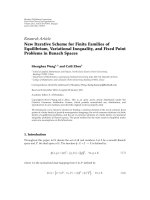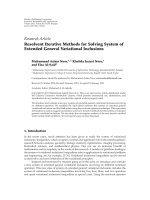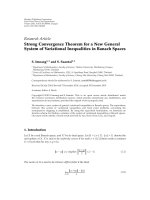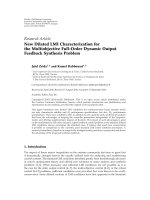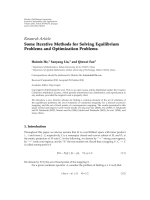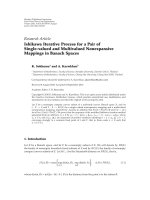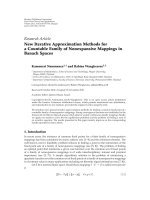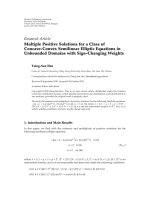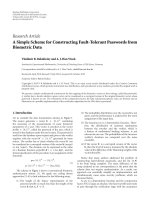Báo cáo hóa học: " Research Article New Iterative Scheme for Finite Families of Equilibrium, Variational Inequality, and Fixed Point Problems in Banach Spaces" doc
Bạn đang xem bản rút gọn của tài liệu. Xem và tải ngay bản đầy đủ của tài liệu tại đây (545.25 KB, 18 trang )
Hindawi Publishing Corporation
Fixed Point Theory and Applications
Volume 2011, Article ID 372975, 18 pages
doi:10.1155/2011/372975
Research Article
New Iterative Scheme for Finite Families of
Equilibrium, Variational Inequality, and Fixed Point
Problems in Banach Spaces
Shenghua Wang
1, 2
and Caili Zhou
3
1
School of Applied Mathematics and Physics, North China Electric Power University,
Baoding 071003, China
2
Department of Mathematics, Gyeongsang National University, Jinju 660-714, Republic of Korea
3
College of Mathematics and Computer, Hebei University, Baoding 071002, China
Correspondence should be addressed to Shenghua Wang,
Received 6 December 2010; Accepted 30 January 2011
Academic Editor: S. Al-Homidan
Copyright q 2011 S. Wang and C. Zhou. This is an open access article distributed under the
Creative Commons Attribution License, which permits unrestricted use, distribution, and
reproduction in any medium, provided the original work is properly cited.
We introduced a new iterative scheme for finding a common element in the set of common fixed
points of a finite family of quasi-φ-nonexpansive mappings, the set of common solutions of a finite
family of equilibrium problems, and the set of common solutions of a finite family of variational
inequality problems in Banach spaces. The proof method for the main result is simplified under
some new assumptions on the bifunctions.
1. Introduction
Throughout this paper, let R denote the set of all real numbers. Let E be a smooth Banach
space and E
∗
the dual space of E. The function φ : E × E → R is defined by
φ
x, y
x
2
−
y, Jx
y
2
, ∀x, y ∈ E,
1.1
where J is the normalized dual mapping from E to E
∗
defined by
J
x
x
∗
∈ E
∗
:
x, x
∗
x
2
x
∗
2
, ∀x ∈ E. 1.2
2 Fixed Point Theory and Applications
Let C be a nonempty closed and convex subset of E. The generalized projection Π : E → C is
a mapping that assigns to an arbitrary point x ∈ E the minimum point of the function φx, y,
that is, Π
C
x x, where x is the solution to the minimization problem
φ
x, x
inf
z∈C
φ
z, x
.
1.3
In Hilbert spaces, φx, yx − y
2
and Π
C
P
C
, where P
C
is the metric projection. It is
obvious from the definition of function φ that
y
−
x
2
≤ φ
y, x
≤
y
x
2
, ∀x, y ∈ E.
1.4
We remark that if E is a reflexive, strictly convex and smooth Banach space, then for x, y ∈ E,
φx, y0 if and only if x y. For more details on φ and Π, the readers are referred to 1–4.
Let T be a mapping from C into itself. We denote the set of fixed points of T by FT. T
is called to be nonexpansive if Tx − Ty≤x − y for all x, y ∈ C and quasi-nonexpansive
if FT
/
∅ and x − Ty≤x − y for all x ∈ FT and y ∈ C.Apointp ∈ C is called to be
an asymptotic fixed point of T 5
if C contains a sequence {x
n
} which converges weakly to p
such that lim
n →∞
x
n
− Tx
n
0. The set of asymptotic fixed points of T is denoted by
FT.
The mapping T is said to be relatively nonexpansive 6–8 if
FTFT and φp, Tx ≤
φp, x for all x ∈ C and p ∈ FT. The mapping T is said to be φ-nonexpansive if φTx,Ty ≤
φx,y for all x, y ∈ C. T is called to be quasi-φ-nonexpansive 9 if FT
/
∅ and φp, Tx ≤
φp, x for all x ∈ C and p
∈ FT.
In 2005, Matsushita and Takahashi 10 introduced the following algorithm:
x
0
x ∈ C,
y
n
J
−1
α
n
Jx
n
1 − α
n
JTx
n
,
C
n
z ∈ C : φ
z, y
n
≤ φ
z, x
n
,
Q
n
{
z ∈ C :
x
n
− z, Jx − Jx
n
≥ 0
}
,
x
n1
P
C
n
∩Q
n
x, ∀n ≥ 0,
1.5
where J is the duality mapping on E, T is a relatively nonexpansive mapping from C into
itself, and {α
n
} is a sequence of real numbers such that 0 ≤ α
n
< 1 and lim sup
n →∞
α
n
< 1and
proved that the sequence {x
n
} generated by 1.5 converges strongly to P
FT
x, where P
FT
is
the generalized projection from C onto FT.
Let f be a bifunction from C × C to R. The equilibrium problem for f is to find p ∈ C
such that
f
p, y
≥ 0, ∀y ∈ C. 1.6
We use EPf to denote the solution set of the equilibrium problem 1.6.Thatis,
EP
f
p ∈ C : f
p, y
≥ 0, ∀y ∈ C
. 1.7
Fixed Point Theory and Applications 3
For studying the equilibrium problem, f is usually assumed to satisfy the following condi-
tions:
A1 fx, x0 for all x ∈ C;
A2 f is monotone, that is, fx, yfy, x ≤ 0 for all x, y ∈ C;
A3 for each x, y, z ∈ C, lim sup
t → 0
ftz 1 − tx, y ≤ fx, y;
A4 for each x ∈ C, y → fx, y is convex and lower semicontinuous.
Recently, many authors investigated the equilibrium problems in Hilbert spaces or Banach
spaces; see, for example, 11–25.In20, Qin et al. considered the following iterative scheme
by a hybrid method in a Banach space:
x
0
∈ E chosen arbitrarily,
C
1
C,
x
1
Π
C
1
x
0
,
y
n
J
−1
α
n,0
Jx
n
N
i1
α
n,i
JT
i
x
n
,
u
n
∈ C such that f
u
n
,y
1
r
n
y − u
n
,Ju
n
− Jy
n
≥ 0, ∀y ∈ C,
C
n1
z ∈ C
n
: φ
z, u
n
≤ φ
z, x
n
,
x
n1
Π
C
n1
x
0
,
1.8
where T
i
: C → C is a closed quasi-φ-nonexpansive mapping for each i ∈{1, 2, ,N},
α
n,0
, {α
n,1
}, ,{α
n,N
} are real sequences in 0, 1 satisfying
N
j0
α
n,j
1 for each n ≥ 1and
lim inf
n →∞
α
n,0
α
n,i
> 0 for each i ∈{1, 2, ,N} and {r
n
} is a real sequence in a, ∞ with a>0.
Then the authors proved that {x
n
} converges strongly to Π
F
x
0
, where F
N
i1
FT
i
∩ EPf.
Very recently, Zegeye and Shahzad 25 introduced a new scheme for finding an
element in the common fixed point set of finite family of closed relatively quasi-nonexpansive
mappings, common solutions set of finite family of equilibrium problems, and common
solutions set of finite family of variational inequality problems for monotone mappings in a
Banach space. More precisely, let f
i
: C×C → R, i 1, 2, ,L, be a finite family of bifunctions,
S
j
: C → C, j 1, ,D, a finite family of relatively quasi-nonexpansive mappings, and
A
i
:C → E
∗
, i 1, 2, ,N, a finite family of continuous monotone mappings. For x ∈ E,
define the mappings F
r
n
, T
r
n
: E → C by
F
r
n
x
z ∈ C :
y − z, A
n
z
1
r
n
y − z, Jz − Jx
≥ 0, ∀y ∈ C
,
T
r
n
x
z ∈ C : f
n
z, y
1
r
n
y − z, Jz − Jx
≥ 0, ∀y ∈ C
,
1.9
4 Fixed Point Theory and Applications
where A
n
A
nmod N
,f
n
f
nmod L
and r
n
⊂ c
1
, ∞ for some c
1
> 0. Zegeye and Shahzad
25 introduced the following scheme:
x
0
∈ C
0
C chosen arbitrarily,
z
n
F
r
n
x
n
,
u
n
T
r
n
x
n
,
y
n
J
−1
α
0
Jx
n
α
1
Jz
n
α
2
JS
n
u
n
,
C
n1
z ∈ C
n
: φ
z, y
n
≤ φ
z, x
n
,
x
n1
Π
C
n1
x
0
,
1.10
where S
n
S
nmod D
, α
0
,α
1
,α
2
∈ 0, 1 such that α
0
α
1
α
2
1. Further, they proved
that {x
n
} converges strongly to an element of F, where F
D
j1
FS
j
∩
N
i1
VIC, A
i
∩
L
l1
EPf
l
.
In this paper, motivated and inspired by the iterations 1.8 and 1.10, we consider
a new iterative process with a finite family of quasi-φ-nonexpansive mappings for a finite
family of equilibrium problems and a finite family of variational inequality problems in a
Banach space. More precisely, let {S
i
}
N
1
i1
: C → C be a family of quasi-φ-nonexpansive
mappings, {f
i
}
N
2
i1
: C × C → R a finite family of bifunctions, and {A
i
}
N
3
i1
: C → E
∗
a
finite family of continuous monotone mappings such that F
N
1
i1
FS
i
∩
N
2
i1
EPf
i
∩
N
3
i1
VIC, A
i
/
∅.Let{r
1,i
}
N
2
i1
⊂ 0, ∞ and {r
2,i
}
N
3
i1
⊂ 0, ∞. Define the mappings T
r
1,i
,
F
r
2,i
: E → C by
T
r
1,i
x
z ∈ C : f
i
z, y
1
r
1,i
y − z, Jz − Jx
≥ 0, ∀y ∈ C
,i 1, ,N
2
, 1.11
F
r
2,i
x
z ∈ C :
y − z, A
i
z
1
r
2,i
y − z, Jz − Jx
≥ 0, ∀y ∈ C
,i 1, ,N
3
.
1.12
Consider the iteration
x
1
∈ C chosen arbitrarily,
y
n
J
−1
α
0
Jx
n
α
1
N
1
i1
λ
1,i
JS
i
x
n
α
2
N
2
i1
λ
2,i
JT
r
1,i
x
n
α
3
N
3
i1
λ
3,i
JF
r
2,i
x
n
,
C
n
v ∈ C : φ
v, y
n
≤ φ
v, x
n
,
D
n
n
i1
C
i
,
x
n1
Π
D
n
x
1
,n≥ 1,
1.13
where α
0
,α
1
,α
2
,α
3
are the real numbers in 0, 1 satisfying α
0
α
1
α
2
α
3
1 and for each
j 1, 2, 3, λ
j,1
, ,λ
j,N
j
are the real numbers in 0, 1 satisfying
N
j
i1
λ
j,i
1. We will prove that
Fixed Point Theory and Applications 5
the sequence {x
n
} generated by 1.13 converges strongly to an element in F. In this paper,
in order to simplify the proof, we will replace the condition A3 with A3’: for each fixed
y ∈ C, f·,y is continuous.
Obviously, the condition A3’ implies A3. Under the condition A3’, we will show
that each T
r
1,i
as well as F
r
2,j
, i 1, ,N
2
, j 1, ,N
3
is closed which is such that the proof
for the main result of this paper is simplified.
2. Preliminaries
The modulus of smoothness of a Banach space E is the function ρ
E
: 0, ∞ → 0, ∞ defined
by
ρ
E
τ
sup
x y
x − y
2
− 1:
x
1;
y
τ
. 2.1
The space E is said to be smooth if ρ
E
τ > 0, for all τ>0, and E is called uniformly smooth
if and only if lim
τ → 0
ρ
E
τ/τ 0.
A Banach space E is said to be strictly convex if x y/2 < 1 for all x, y ∈ E with
x y 1andx
/
y. It is said to be uniformly convex if lim
n →∞
x
n
− y
n
0 for any
two sequences {x
n
} and {y
n
} in E such that x
n
y
n
1 and lim
n →∞
x
n
y
n
/2 1.
It is known that if a Banach space E is uniformly smooth, then its dual space E
∗
is uniformly
convex.
A Banach space E is called to have the Kadec-Klee property if for any sequence {x
n
}⊂
E and x ∈ E with x
n
x, where denotes the weak convergence, and x
n
→x, then
x
n
− x → 0asn →∞, where → denotes the strong convergence. It is well known that
every uniformly convex Banach space has the Kadec-Klee property. For more details on the
Kadec-Klee property, the reader is referred to 3, 4.
Let C be a nonempty closed and convex subset of a Banach space E. A mapping S :
C → C is said to be closed if for any sequence {x
n
}⊂C such that lim
n →∞
x
n
x
0
and
lim
n →∞
Sx
n
y
0
, Sx
0
y
0
.
Let A : DA ⊂ E → E
∗
be a mapping. A is said to be monotone if for each x, y ∈ DA,
the following inequality holds:
x − y, Ax − Ay
≥ 0. 2.2
Let A be a monotone mapping from C into E
∗
. The variational inequality problem on A is
formulated as follows:
find a point u ∈ C such that
v − u, Au
≥ 0, ∀v ∈ C. 2.3
The solution set of the above variational inequality problem is denoted by VIC, A.
6 Fixed Point Theory and Applications
Next we state some lemmas which will be used later.
Lemma 2.1 see 1. Let C be a nonempty closed and convex subset of a smooth Banach space E and
x ∈ E. Then, x
0
Π
C
x if and only if
x
0
− y, Jx − Jx
0
≥ 0 ∀y ∈ C. 2.4
Lemma 2.2 see 1. Let E be a reflexive, strictly convex and smooth Banach space, C a nonempty
closed and convex subset of E, and x ∈ E. Then
φ
y, Π
C
x
φ
Π
C
x, x
≤ φ
y, x
, ∀y ∈ C. 2.5
Lemma 2.3 see 20. Let E be a strictly convex and smooth Banach space, C a nonempty closed
and convex subset of E, and T : C → C a quasi-φ-nonexpansive mapping. Then FT is a closed and
convex subset of C.
Since the condition A3’ implies A3, the following lemma is a natural result of 22,
Lemmas 2.8 and 2.9.
Lemma 2.4. Let C be a closed and convex subset of a smooth, strictly convex and reflexive Banach
space E. Let f be a bifunction from C × C → R satisfying (A1), (A2), (A3’), and (A4). Let r > 0 and
x ∈ E. Then
a there exists z ∈ C such t hat
f
z, y
1
r
y − z, Jz − Jx
≥ 0, ∀y ∈ C;
2.6
b define a mapping T
r
: E → Cby
T
r
x
z ∈ C : f
z, y
1
r
y − z, Jz − Jx
≥ 0, ∀y ∈ C
. 2.7
Then the following conclusions hold:
1 T
r
is single-valued;
2 T
r
is firmly nonexpansive, that is, for all x, y ∈ E,
T
r
x − T
r
y, JT
r
x − JT
r
y
≤
T
r
x − T
r
y, Jx − Jy
; 2.8
3 FT
r
EPf;
4 T
r
is quasi-φ-nonexpansive;
5 EPf is closed and convex;
6 φp, T
r
xφT
r
x, x ≤ φp, x, for all p ∈ FT
r
.
Fixed Point Theory and Applications 7
Remark 2.5. Let A : C → E
∗
be a continuous monotone mapping and define fx, yy −
x, Ax for all x, y ∈ C. It is easy to see that f satisfies the conditions A1, A2, A3’,and
A4 and EPfVIC, A. Hence, for every real number r>0, if defining a mapping F
r
:
E → C by
F
r
x
z ∈ C :
y − z, Az
1
r
y − z, Jz − Jx
≥ 0, ∀y ∈ C
, 2.9
then F
r
satisfies all the conclusions in Lemma 2.4.See25, Lemma 2.4.
Lemma 2.6 see 26. Let p > 1 and s > 0 be two fixed real numbers. Then a Banach space E is
uniformly convex if and only if there exists a continuous strictly increasing convex function g : 0, ∞
with g00 such that
λx
1 − λ
y
p
≤ λ
x
p
1 − λ
y
2
− w
p
λ
g
x − y
2.10
for all x, y ∈ B
s
0{x ∈ E : x≤s} and λ ∈ 0, 1,wherew
p
λλ
p
1 − λλ1 − λ
p
.
The following lemma can be obtained from Lemma 2.6 immediately; also see 20,
Lemma 1.9.
Lemma 2.7 see 20. Let E be a uniformly convex Banach space, s > 0 a positive number, and B
s
0
a closed ball of E. There exists a continuous, strictly increasing and convex function g : 0, ∞ with
g00 such that
N
i1
α
i
x
i
2
≤
N
i1
α
i
x
i
2
− α
j
α
k
g
x
j
− x
k
,j,k∈
{
1, 2, ,N
}
with j
/
k
2.11
for all x
1
,x
2
, ,x
N
∈ B
s
0{x ∈ E : x≤s} and α
1
,α
2
, ,α
N
∈ 0, 1 such that
N
i1
α
i
1.
Lemma 2.8. Let C be a closed and convex subset of a uniformly smooth and strictly convex Banach
space E. Let f : C × C → R be a bifunction satisfying (A1), (A2), (A3’), and (A4). Let r > 0 and
T
r
: E → C be a mapping defined by 2.7.ThenT
r
is closed.
Proof. Let {x
n
}⊂E converge to x
and {T
r
x
n
} converge to x. To end the conclusion, we need
to prove that T
r
x
x. Indeed, for each x
n
, Lemma 2.4 shows that there exists a unique z
n
∈ C
such that z
n
T
r
x
n
,thatis,
f
z
n
,y
1
r
y − z
n
,Jz
n
− Jx
n
≥ 0, ∀y ∈ C.
2.12
8 Fixed Point Theory and Applications
Since E is uniformly smooth, J is continuous on bounded set note that {x
n
} and {z
n
} are
both bounded. Taking the limit as n →∞in 2.12,byusingA3’,weget
f
x, y
1
r
y − x, J x − Jx
≥ 0, ∀y ∈ C,
2.13
which implies that T
r
x
x. This completes t he proof.
3. Main Results
Theorem 3.1. Let C be a nonempty closed and convex subset of a uniformly smooth and strictly
convex Banach space E which has the Kadec-Klee property. Let {S
i
}
N
1
i1
: C → C be a family of closed
quasi-φ-nonexpansive mappings, {f
i
}
N
2
i1
: C × C → R a finite family of bifunctions satisfying the
conditions (A1), (A2), (A3’), and (A4), and {A
i
}
N
3
i1
: C → E
∗
a finite family of continuous monotone
mappings such that F
N
1
i1
FS
i
∩
N
2
i1
EPf
i
∩
N
3
i1
VIC, A
i
/
∅.Let{r
1,i
}
N
2
i1
, {r
2,i
}
N
3
i1
⊂
0, ∞.Let{x
n
} be a sequence generated by the following manner:
x
1
∈ C chosen arbitrarily,
z
n
N
1
i1
λ
1,i
JS
i
x
n
,
u
n
N
2
i1
λ
2,i
JT
r
1,i
x
n
,
w
n
N
3
i1
λ
3,i
JF
r
2,i
x
n
,
y
n
J
−1
α
0
Jx
n
α
1
z
n
α
2
u
n
α
3
w
n
,
C
n
z ∈ C : φ
v, y
n
≤ φ
v, x
n
,
D
n
n
i1
C
i
,
x
n1
Π
D
n
x
1
,n≥ 1,
3.1
where T
r
1,i
i 1, 2, ,N
2
and F
r
2,j
j 1, 2, ,N
3
are defined by 1.11 and 1.12, α
0
,α
1
,α
2
,α
3
are the real numbers in 0, 1 satisfying α
0
α
1
α
2
α
3
1 and for each j 1, 2, 3, λ
j,1
, ,λ
j,N
j
are the real numbers in 0, 1 satisfying
N
j
i1
λ
j,i
1. Then the sequence {x
n
} converges strongly to
Π
F
x
1
,whereΠ
F
is the generalized projection from E onto F.
Proof. First we prove that D
n
is closed and convex for each n ≥ 1. From the definition of C
n
,
it is obvious that C
n
is closed. Moreover, since φv, y
n
≤ φv, x
n
is equivalent to 2v, Jx
n
−
Jy
n
−x
n
2
y
n
2
≥ 0, it follows that C
n
is convex for each n ≥ 1. By the definition of D
n
,
we can conclude that D
n
is closed and convex for each n ≥ 1.
Fixed Point Theory and Applications 9
Next, we prove that F⊂D
n
for each n ≥ 1. From Lemma 2.4 and Remark 2.5,wesee
that each T
r
1,i
i 1, 2, ,N
2
and F
r
2,j
j 1, 2, ,N
3
are quasi-φ-nonexpansive. Hence, for
any p ∈F, we have
φ
p, y
n
φ
p, J
−1
α
0
Jx
n
α
1
z
n
α
2
u
n
α
3
w
n
p
2
− 2
p, α
0
Jx
n
α
1
z
n
α
2
u
n
α
3
w
n
α
0
Jx
n
α
1
z
n
α
2
u
n
α
3
w
n
2
≤
p
2
− 2α
0
p, Jx
n
− 2α
1
p, z
n
− 2α
2
p, u
n
− 2α
3
p, w
n
α
0
x
n
2
α
1
z
n
2
α
2
u
n
2
α
3
w
n
2
≤
p
2
− 2α
0
p, Jx
n
− 2α
1
N
1
i1
λ
1,i
p, JS
i
x
n
− 2α
2
N
2
i1
λ
2,i
p, JT
r
1,i
x
n
− 2α
3
N
3
i1
λ
3,i
p, JF
r
2,i
x
n
α
0
x
n
2
α
1
N
1
i1
λ
1,i
JS
i
x
n
2
α
2
N
2
i1
λ
2,i
JT
r
1,i
x
n
2
α
3
N
3
i1
λ
3,i
JF
r
2,i
x
n
2
α
0
φ
p, x
n
α
1
N
1
i1
λ
1,i
φ
p, S
i
x
n
α
2
N
2
i1
λ
2,i
φ
p, T
r
1,i
x
n
α
3
N
3
i1
λ
3,i
φ
p, F
r
2,i
x
n
≤ α
0
φ
p, x
n
α
1
N
1
i1
λ
1,i
φ
p, x
n
α
2
N
2
i1
λ
2,i
φ
p, x
n
α
3
N
3
i1
λ
3,i
φ
p, x
n
φ
p, x
n
,
3.2
which implies that F⊂C
n
for each n ≥ 1. So, it follows from the definition of D
n
that F ⊂ D
n
for each n ≥ 1. Therefore, the sequence {x
n
} is well defined. Also, from Lemma 2.2 we see
that
φ
x
n1
,x
1
φ
Π
D
n
x
1
,x
1
≤ φ
p, x
1
− φ
p, x
n1
≤ φ
p, x
1
, 3.3
for each p ∈F. This shows that the sequence {φx
n
,x
1
} is bounded. It follows from 1.4 that
the sequence {x
n
} is also bounded.
10 Fixed Point Theory and Applications
Since E is reflexive, we may, without loss of generality, assume that x
n
x
∗
. Since D
n
is closed and convex for each n ≥ 1, we can conclude that x
∗
∈ D
n
for each n ≥ 1. By the
definition of {x
n
},weseethat
φ
x
n
,x
1
≤ φ
x
∗
,x
1
. 3.4
It follows that
φ
x
∗
,x
1
≤ lim inf
n →∞
φ
x
n
,x
1
≤ lim sup
n →∞
φ
x
n
,x
1
≤ φ
x
∗
,x
1
.
3.5
This implies that
lim
n →∞
φ
x
n
,x
1
φ
x
∗
,x
1
.
3.6
Hence, we have x
n
→x
∗
as n →∞. In view of the Kadec-Klee property of E,weget
that
lim
n →∞
x
n
x
∗
.
3.7
By the construction of D
n
, we have that D
n1
⊂ D
n
and x
n2
Π
D
n1
x
1
⊂ D
n
. It follows
from Lemma 2.2 that
φ
x
n2
,x
n1
φ
x
n2
, Π
D
n
x
1
≤ φ
x
n2
,x
1
− φ
Π
D
n
x
1
,x
1
φ
x
n2
,x
1
− φ
x
n1
,x
1
.
3.8
Letting n →∞,weobtainthatφx
n2
,x
n1
→ 0. In view of x
n1
∈ D
n
n
i1
C
n
, we have
x
n1
∈ C
n
and hence
φ
x
n1
,y
n
≤ φ
x
n1
,x
n
. 3.9
It follows that
lim
n →∞
φ
x
n1
,y
n
0.
3.10
From 1.4,weseethat
y
n
−→
x
∗
as n →∞. 3.11
Fixed Point Theory and Applications 11
Hence,
Jy
n
−→
Jx
∗
as n →∞. 3.12
This implies that the sequence {Jy
n
} is bounded. Note that reflexivity of E implies reflexivity
of E
∗
. Thus, we may assume that Jy
n
y∈ E
∗
. Furthermore, reflexivity of E implies that
there exists x ∈ E such that y Jx. Then, it follows that
φ
x
n1
,y
n
x
n1
2
− 2
x
n1
,Jy
n
y
n
2
x
n1
2
− 2
x
n1
,Jy
n
Jy
n
2
.
3.13
Take lim inf on both sides of 3.13 over n and use weak lower semicontinuity of norm to get
that
0 ≥
x
∗
2
− 2
x
∗
,y
y
2
x
∗
2
− 2
x
∗
,Jx
Jx
2
x
∗
2
− 2
x
∗
,Jx
x
2
φ
x
∗
,x
,
3.14
which implies that x
∗
x. Hence, y Jx
∗
. It follows that Jy
n
Jx
∗
.Now,from3.12 and
Kadec-Klee property of E
∗
,weobtainthatJy
n
→ Jx
∗
as n →∞. T hen the demicontinuity of
J
−1
implies that y
n
x
∗
.Now,from3.11 and the fact that E has the Kadec-Klee property,
we obtain that lim
n →∞
y
n
x
∗
.Notethat
x
n
− y
n
≤
x
n
− x
∗
x
∗
− y
n
. 3.15
It follows that
lim
n →∞
x
n
− y
n
0.
3.16
Since J is uniformly norm-to-norm continuous on any bounded sets, we have
lim
n →∞
Jx
n
− Jy
n
0.
3.17
12 Fixed Point Theory and Applications
Since E is uniformly smooth, we know that E
∗
is uniformly convex. In view of
Lemma 2.7, we see that, for any p ∈F,
φ
p, y
n
φ
p, J
−1
α
0
Jx
n
α
1
z
n
α
2
u
n
α
3
w
n
p
2
−2
p, α
0
Jx
n
α
1
z
n
α
2
u
n
α
3
w
n
α
0
Jx
n
α
1
z
n
α
2
u
n
α
3
w
n
2
≤
p
2
− 2
p, α
0
Jx
n
α
1
z
n
α
2
u
n
α
3
w
n
α
0
x
n
2
α
1
N
1
i1
λ
1,i
S
i
x
n
2
α
2
N
2
i1
λ
2,i
T
r
1,i
x
n
2
α
3
N
3
i1
λ
3,i
F
r
2,i
x
n
2
− α
0
α
1
λ
1,1
g
Jx
n
− JS
1
x
n
α
0
φ
p, x
n
α
1
N
1
i1
λ
1,i
φ
p, S
i
x
n
α
2
N
2
i1
λ
2,i
φ
p, T
r
1,i
x
n
α
3
N
3
i1
λ
3,i
φ
p, F
r
2,i
x
n
− α
0
α
1
λ
1,1
g
Jx
n
− JS
1
x
n
≤ α
0
φ
p, x
n
α
1
N
1
i1
λ
1,i
φ
p, x
n
α
2
N
2
i1
λ
2,i
φ
p, x
n
α
3
N
3
i1
λ
3,i
φ
p, x
n
− α
0
α
1
λ
1,1
g
Jx
n
− JS
1
x
n
φ
p, x
n
− α
0
α
1
λ
1,1
g
Jx
n
− JS
1
x
n
.
3.18
It follows that
α
0
α
1
λ
1,1
g
Jx
n
− JS
1
x
n
≤ φ
p, x
n
− φ
p, y
n
. 3.19
Note that
φ
p, x
n
− φ
p, y
n
x
n
2
−
y
n
2
− 2
p, Jx
n
− Jy
n
≤
x
n
− y
n
x
n
y
n
2
p
Jx
n
− Jy
n
.
3.20
It follows from 3.16 and 3.17 that
φ
p, x
n
− φ
p, y
n
−→ 0asn −→ ∞ . 3.21
By 3.19, 3.21,andα
0
α
1
λ
1,1
> 0, we have
g
Jx
n
− JS
1
x
n
−→ 0asn −→ ∞ . 3.22
Fixed Point Theory and Applications 13
It follows from the property of g that
Jx
n
− JS
1
x
n
−→ 0asn −→ ∞ . 3.23
Since x
n
→ x
∗
as n →∞and J : E → E
∗
is demicontinuous, we obtain that Jx
n
Jx
∗
∈ E
∗
.
Note that
|
Jx
n
−
Jx
∗
|
|
x
n
−
x
∗
|
≤
x
n
− x
∗
. 3.24
This implies that
lim
n →∞
Jx
n
Jx
∗
.
3.25
Since E
∗
enjoys the Kadec-Klee property, we see that
lim
n →∞
Jx
n
− Jx
∗
0.
3.26
Note that
JS
1
x
n
− Jx
∗
≤
JS
1
x
n
− Jx
n
Jx
n
− Jx
∗
. 3.27
From 3.23 and 3.26, we arrive at
lim
n →∞
JS
1
x
n
− Jx
∗
0.
3.28
Note that J
−1
: E
∗
→ E is demicontinuous. It follows that S
1
x
n
x
∗
. On the other hand,
since
|
S
1
x
n
−
x
∗
|
|
JS
1
x
n
−
Jx
∗
|
≤
JS
1
x
n
− Jx
∗
, 3.29
by 3.28 we conclude that S
1
x
n
→x
∗
as n →∞. Since E enjoys the Kadec-Klee prop-
erty, we obtain that
lim
n →∞
S
1
x
n
− x
∗
0.
3.30
By repeating 3.18–3.30, we also can get
lim
n →∞
S
i
x
n
− x
∗
0,i 2, ,N
1
,
3.31
lim
n →∞
T
r
1,i
x
n
− x
∗
0,i 1, ,N
2
, 3.32
lim
n →∞
F
r
2,i
x
n
− x
∗
0,i 1, ,N
3
.
3.33
14 Fixed Point Theory and Applications
Since each S
i
is closed, by 3.30 and 3.31 we conclude that S
i
x
∗
x
∗
,thatis,
x
∗
∈ FS
i
, i 1, 2, ,N
1
. On the other hand, Lemma 2.4, Remark 2.5,andLemma 2.8
show that T
r
1,i
i 1, 2, ,N
2
and F
r
2,i
i 1, 2, ,N
3
are closed. So, by 3.32 and 3.33
we have T
r
1,i
x
∗
x
∗
i 1, 2, ,N
2
and F
r
2,i
x
∗
x
∗
i 1, 2, ,N
3
. Now, it follows from
Lemma 2.4 and Remark 2.5 that FT
r
1,i
EPf
i
i 1, 2, ,N
2
and FF
r
2,i
VIC, A
i
i 1, 2, ,N
3
. Hence, x
∗
∈ EPf
i
i 1, 2, ,N
2
and x
∗
∈ VIC, A
i
i 1, 2, ,N
3
.
Therefore, x
∗
∈F.
Finally, we prove that x
∗
Π
F
x
1
.Fromx
n1
Π
D
n
x
1
,byLemma 2.1,weseethat
x
n1
− p, Jx
1
− Jx
n1
≥ 0, ∀p ∈ D
n
. 3.34
Since F⊂D
n
for each n ≥ 1, we have
x
n1
− p, Jx
1
− Jx
n1
≥ 0, ∀p ∈F. 3.35
Letting n →∞in 3.35,weseethat
x
∗
− p, Jx
1
− Jp
≥ 0, ∀p ∈F. 3.36
In view of Lemma 2.1, we can obtain that x
∗
Π
F
x
1
. This completes the proof.
Remark 3.2. Obviously, the proof process of x
∗
∈
N
2
i1
EPf
i
∩
N
3
i1
VIC, A
i
is simple since
we replace the condition A3 with A3’ which is such that T
r
1,i
and F
r
2,j
i 1, 2, ,N
2
,j
1, 2, ,N
3
are closed. In fact, although the condition A3’ is stronger than A3,itisnot
easier to verify the condition A3 than verify the condition A3’. Hence, from this point, the
condition A3’ is acceptable. On the other hand, the definition of D
n
is of some interest.
If S
i
S for each i 1, 2, ,N
1
, f
i
f for each i 1, 2, ,N
2
and A
i
A for each
i 1, 2, ,N
3
, then Theorem 3.1 reduces to the following result.
Corollary 3.3. Let C be a nonempty closed and convex subset of a uniformly smooth and strictly
convex Banach space E which has the Kadec-Klee property. Let S : C → C be a closed quasi-φ-
nonexpansive mapping, f : C × C → R a bifunction satisfying the conditions (A1), (A2), (A3’), and
(A4) and A : C → E
∗
a continuous monotone mapping such that F FS ∩ EPf ∩ VIC, A
/
∅.
Let r
1
, r
2
⊂ 0, ∞.Let{x
n
} be a sequence defined by the following manner:
x
1
∈ C chosen arbitrarily,
y
n
J
−1
α
0
Jx
n
α
1
JSx
n
α
2
JT
r
1
x
n
α
3
JF
r
2
x
n
,
C
n
z ∈ C : φ
v, y
n
≤ φ
v, x
n
,
D
n
n
i1
C
i
,
x
n1
Π
D
n
x
1
,n≥ 1,
3.37
Fixed Point Theory and Applications 15
where T
r
1
and F
r
2
are defined by 1.11 and 1.12 with r
1,i
r
1
i 1, 2, ,N
2
and r
2,j
r
2
j
1, 2, ,N
3
, α
0
,α
1
,α
2
,α
3
are the real numbers in 0, 1 satisfying α
0
α
1
α
2
α
3
1. Then the
sequence {x
n
} converges strongly to P
F
x
1
,whereΠ
F
is the generalized projection from E onto F.
Corollary 3.4. Let C be a nonempty closed and convex subset of a Hilbert space H. Let {S
i
}
N
1
i1
: C →
C be a family of closed quasi-nonexpansive mappings, {f
i
}
N
2
i1
: C×C → R a finite family of bifunctions
satisfying the conditions (A1)–(A4), and {A
i
}
N
3
i1
: C → H a finite family of continuous monotone
mappings such that F
N
1
i1
FS
i
∩
N
2
i1
EPf
i
∩
N
3
i1
VIC, A
i
/
∅.Let{r
1,i
}
N
2
i1
, {r
2,i
}
N
3
i1
⊂
0, ∞. Define a sequence {x
n
} by the following manner:
x
1
∈ C chosen arbitrarily,
z
n
N
1
i1
λ
1,i
S
i
x
n
,
u
n
N
2
i1
λ
2,i
T
r
1,i
x
n
,
w
n
N
3
i1
λ
3,i
F
r
2,i
x
n
,
y
n
α
0
x
n
α
1
z
n
α
2
u
n
α
3
w
n
,
C
n
z ∈ C :
v − y
n
≤
v − x
n
,
D
n
n
i1
C
i
,
x
n1
P
D
n
x
1
,n≥ 1,
3.38
where {T
r
1,i
}
N
2
i1
and {F
r
1,i
}
N
3
i1
are defined by 1.11 and 1.12 with J I (I is the identity mapping),
α
0
,α
1
,α
2
,α
3
are the real numbers in 0, 1 satisfying α
0
α
1
α
2
α
3
1 and for each j 1, 2, 3,
λ
j,1
, ,λ
j,N
j
are the real numbers in 0, 1 satisfying
N
j
i1
λ
j,i
1. Then the sequence {x
n
} converges
strongly to P
F
x
1
,whereP
F
is the projection from H onto F.
Proof. By the proof of Theorem 3.1, we have x
n
→ x
∗
as n →∞,
lim
n →∞
S
i
x
n
− x
n
0,i 1, 2, ,N
1
,
lim
n →∞
T
r
1,i
x
n
− x
n
0,i 1, 2, ,N
2
,
lim
n →∞
F
r
2,i
x
n
− x
n
0,i 1, 2, ,N
3
.
3.39
Since each S
i
is closed, we can conclude that x
∗
∈ FS
i
, i 1, 2, ,N
1
.Notethatina
Hilbert space, a firmly-nonexpansive mapping is also nonexpansive. Hence, T
r
1
,i
and F
r
2,j
are
nonexpansive for each i 1, 2, ,N
2
and j 1, 2, ,N
3
. By demiclosed principle, we can
conclude that x
∗
∈ FT
r1,i
EPf
i
and x
∗
∈ FF
r2,i
VIC, A
j
for each i 1, 2, ,N
2
and j 1, 2, ,N
3
.Thatis,x
∗
∈F. Then by the final part of proof of Theorem 3.1, we have
x
n
→ x
∗
P
F
x
1
. This completes the proof.
16 Fixed Point Theory and Applications
Let H be a Hilbert space and C a nonempty closed and convex subset of H. A mapping
T : C → H is called a pseudocontraction if for all x, y ∈ C,
Tx − Ty
2
≤
x − y
2
I − T
x −
I − T
y
2
,
3.40
or equivalently,
I − T
x −
I − T
y, x − y
≥ 0. 3.41
Let A I − T, where T : C → H is a pseudocontraction. Then A is a monotone
mapping and A
−1
0FT. Moreover, FTVIC, A. Indeed, it is easy to see that FT ⊂
VIC, A.Letu ∈ VIC, A. We have
v − u, Au
≥ 0, i.e.,
v − u,
I − T
u
≥ 0, 3.42
for all v ∈ C. Take v Tu. Then we have Tu − u, I − Tu≥0. That is, −u − Tu
2
≥ 0. This
shows that u Tu, which implies that VIC, A ⊂ FT.So,FTVIC, A.Basedthis,we
have following result.
Corollary 3.5. Let C be a nonempty closed and convex subset of a Hilbert space H. Let {S
i
}
N
1
i1
:
C → C be a family of closed quasi-nonexpansive mappings, {f
i
}
N
2
i1
: C × C → R a finite
family of bifunctions satisfying the conditions (A1)–(A4), and {T
i
}
N
3
i1
: C → H a finite family of
continuous pseudocontractions such that F
N
1
i1
FS
i
∩
N
2
i1
EPf
i
∩
N
3
i1
FT
i
/
∅.Let
{r
1,i
}
N
2
i1
, {r
2,i
}
N
3
i1
⊂ 0, ∞. Define a sequence {x
n
} by the following manner:
x
1
∈ C chosen arbitrarily,
z
n
N
1
i1
λ
1,i
S
i
x
n
,
u
n
N
2
i1
λ
2,i
T
r
1,i
x
n
,
w
n
N
3
i1
λ
3,i
F
r
2,i
x
n
,
y
n
α
0
x
n
α
1
z
n
α
2
u
n
α
3
w
n
,
C
n
z ∈ C :
v − y
n
≤
v − x
n
,
D
n
n
i1
C
i
,
x
n1
P
D
n
x
1
,n≥ 1,
3.43
Fixed Point Theory and Applications 17
where {T
r
1,i
}
N
2
i1
are defined by 1.11 with J I and F
r
2,i
is defined by
F
r
2,i
x
z ∈ C :
y − x,
I − T
i
x
1
r
2,i
y − z, z − x
≥ 0 ∀y ∈ C
,i 1, 2, ,N
3
,
3.44
α
0
,α
1
,α
2
,α
3
are the real numbers in 0, 1 satisfying α
0
α
1
α
2
α
3
1 and for each j 1, 2, 3,
λ
j,1
, ,λ
j,N
j
are the real numbers in 0, 1 satisfying
N
j
i1
λ
j,i
1. Then the sequence {x
n
} converges
strongly to P
F
x
1
,whereP
F
is the projection from H onto F.
If S
i
S, f
j
f,andT
k
T for each i 1, 2, ,N
1
, j 1, 2, ,N
2
,and
k 1, 2, ,N
3
, then Corollary 3.5 reduced the following result.
Corollary 3.6. Let C be a nonempty closed and convex subset of a Hilbert space H. Let S : C → C
be a closed quasi-nonexpansive mapping, f : C × C → R a bifunction satisfying the conditions (A1)–
(A4), and T : C → H a continuous pseudocontraction such that F FS ∩ EPf ∩ FT
/
∅.Let
r
1
, r
2
⊂ 0, ∞. Define a sequence {x
n
} by the following manner:
x
1
∈ C chosen arbitrarily,
y
n
J
−1
α
0
x
n
α
1
Sx
n
α
2
T
r
1
x
n
α
3
F
r
2
x
n
,
C
n
z ∈ C :
v − y
n
≤
v − x
n
,
D
n
n
i1
C
i
,
x
n1
P
D
n
x
1
,n≥ 1,
3.45
where T
r
1
is defined by 1.11 with J I and r
1,i
r
1
i 1, 2, ,N
2
, F
r
2
is defined by 3.44 r
2,j
r
2
j 1, 2, ,N
3
, and α
0
,α
1
,α
2
,α
3
are the real numbers in 0, 1 satisfying α
0
α
1
α
2
α
3
1.
Then the sequence {x
n
} converges strongly to P
F
x
1
,whereP
F
is the projection from H onto F.
Acknowledgment
This work was supported by the Natural Science Foundation of Hebei Province
A2010001482.
References
1 Y. I. Alber, “Metric and generalized projection operators in Banach spaces: properties and
applications,” in Theory and Applications of Nonlinear Operators of Accretive and Monotone Type, vol.
178 of Lecture Notes in Pure and Appl. Math., pp. 15–50, Dekker, New York, NY, USA, 1996.
2 Ya. I. Alber and S. Reich, “An iterative method for solving a class of nonlinear operator equations in
Banach spaces,” Panamerican Mathematical Journal, vol. 4, no. 2, pp. 39–54, 1994.
3 I. Cioranescu, Geometry of Banach Spaces, Duality Mappings and Nonlinear Problems, vol. 62 of
Mathematics and Its Applications, Kluwer Academic Publishers, Dordrecht, The Netherlands, 1990.
4 W. Takahashi, Nonlinear Functional Analysis, Yokohama Publishers, Yokohama, Japan, 2000, Fixed
point theory and Its application.
5 S. Reich, “A weak convergence theorem for the alternating method with Bregman distances,” in
Theory and Applications of Nonlinear Operators of Accretive and Monotone Type, A. G. Kartsatos, Ed., vol.
178 of Lecture Notes in Pure and Appl. Math., pp. 313–318, Dekker, New York, NY, USA, 1996.
18 Fixed Point Theory and Applications
6 D. Butnariu, S. Reich, and A. J. Zaslavski, “Asymptotic behavior of relatively nonexpansive operators
in Banach spaces,” Journal of Applied Analysis, vol. 7, no. 2, pp. 151–174, 2001.
7 D. Butnariu, S. Reich, and A. J. Zaslavski, “Weak convergence of orbits of nonlinear operators in
reflexive Banach spaces,” Numerical Functional Analysis and Optimization, vol. 24, no. 5-6, pp. 489–508,
2003.
8 Y. Censor and S. Reich, “Iterations of paracontractions and firmly nonexpansive operators with
applications to feasibility and optimization,” Optimization, vol. 37, no. 4, pp. 323–339, 1996.
9 H. Zhou, G. Gao, and B. Tan, “Convergence theorems of a modified hybrid algorithm for a family of
quasi-φ-asymptotically nonexpansive mappings,” Journal of Applied Mathematics and Computing, vol.
32, no. 2, pp. 453–464, 2010.
10 S y. Matsushita and W. Takahashi, “A strong convergence theorem for relatively nonexpansive
mappings in a Banach space,” Journal of Approximation Theory, vol. 134, no. 2, pp. 257–266, 2005.
11 L C. Ceng and J C. Yao, “Hybrid viscosity approximation schemes for equilibrium problems
and fixed point problems of infinitely many nonexpansive mappings,” Applied Mathematics and
Computation, vol. 198, no. 2, pp. 729–741, 2008.
12 L C. Ceng, S. Al-Homidan, Q. H. Ansari, and J C. Yao, “An iterative scheme for equilibrium
problems and fixed point problems of strict pseudo-contraction mappings,” Journal of Computational
and Applied Mathematics, vol. 223, no. 2, pp. 967–974, 2009.
13 L. C. Ceng, A. Petrus¸el, and J. C. Yao, “Iterative approaches to solving equilibrium problems and
fixed point problems of infinitely many nonexpansive mappings,” Journal of Optimization Theory and
Applications, vol. 143, no. 1, pp. 37–58, 2009.
14 S S. Chang, Y. J. Cho, and J. K. Kim, “Approximation methods of solutions for equilibrium problem
in Hilbert spaces,” Dynamic Systems and Applications, vol. 17, no. 3-4, pp. 503–513, 2008.
15 S S. Chang, H. W. Joseph Lee, and C. K. Chan, “A new method for solving equilibrium problem
fixed point problem and variational inequality problem with application to optimization,” Nonlinear
Analysis: Theory, Methods & Applications, vol. 70, no. 9, pp. 3307–3319, 2009.
16 P. Kumam and P. Katchang, “A viscosity of extragradient approximation method for finding equi-
librium problems, variational inequalities and fixed point problems for nonexpansive mappings,”
Nonlinear Analysis: Hybrid Systems, vol. 3, no. 4, pp. 475–486, 2009.
17 A. Moudafi, “Weak convergence theorems for nonexpansive mappings and equilibrium problems,”
Journal of Nonlinear and Convex Analysis, vol. 9, no. 1, pp. 37–43, 2008.
18 S. Plubtieng and R. Punpaeng, “A new iterative method for equilibrium problems and fixed
point problems of nonexpansive mappings and monotone mappings,” Applied Mathematics and
Computation, vol. 197, no. 2, pp. 548–558, 2008.
19 X. Qin, Y. J. Cho, and S. M. Kang, “Viscosity approximation methods for generalized equilibrium
problems and fixed point problems with applications,” Nonlinear Analysis: Theory, Methods &
Applications, vol. 72, no. 1, pp. 99–112, 2010.
20 X. Qin, S. Y. Cho, and S. M. Kang, “Strong convergence of shrinking projection methods for quasi-φ-
nonexpansive mappings and equilibrium problems,” Journal of Computational and Applied Mathematics,
vol. 234, no. 3, pp. 750–760, 2010.
21 S. Takahashi and W. Takahashi, “Viscosity approximation methods for equilibrium problems and
fixed point problems in Hilbert spaces,” Journal of Mathematical Analysis and Applications, vol. 331, no.
1, pp. 506–515, 2007.
22 W. Takahashi and K. Zembayashi, “Strong and weak convergence theorems for equilibrium problems
and relatively nonexpansive mappings in Banach spaces,” Nonlinear Analysis: Theory, Methods &
Applications, vol. 70, no. 1, pp. 45–57, 2009.
23 S. Wang, G. Marino, and F. Wang, “Strong convergence theorems for a generalized equilibrium
problem with a relaxed monotone mapping and a countable family of nonexpansive mappings in
a Hilbert space,” Fixed Point Theory and Applications, vol. 2010, Article ID 230304, 22 pages, 2010.
24 Y. J. Cho, S. Wang, and X. Qin, “A new iterative method for solving equilibrium problems and fixed
point problems for infinite family of nonexpansive mappings,” Fixed Point Theory and Applications,
vol. 2010, Article ID 165098, 18 pages, 2010.
25 H. Zegeye and N. Shahzad, “A hybrid scheme for finite families of equilibrium, variational inequality
andfixedpointproblems,”Nonlinear Analysis: Theory, Methods & Applications, vol. 74, no. 1, pp. 263–
272, 2011.
26 H. K. Xu, “Inequalities in Banach spaces with applications,” Nonlinear Analysis: Theory, Methods &
Applications, vol. 16, no. 12, pp. 1127–1138, 1991.
